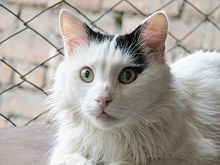Turkish Van
| Turkish Van | |
|---|---|

A Turkish Van
|
|
| Other names | Turkish Cat (obsolete) |
| Origin |
|
| Breed standards | |
| CFA | standard |
| FIFe | standard |
| TICA | standard |
| AACE | standard |
| ACF | standard |
| ACFA/CAA | standard |
| GCCF | standard |
| Domestic cat (Felis catus) | |
The Turkish Van is a semi-long-haired breed of domestic cat, which was developed in the United Kingdom from a selection of cats obtained from various cities of modern Turkey, especially Southeast Turkey. The breed is rare, and is distinguished by the Van pattern (named for the breed), where the colour is restricted to the head and the tail, and the rest of the cat is white; this is due to the expression of the piebald white spotting gene, a type of partial leucism. A Turkish Van may have blue or amber eyes, or be odd-eyed (having one eye of each colour). The breed has been claimed to be descended from the landrace of usually all-white Van cats (Turkish: Van kedisi), mostly found near Lake Van, though one of the two original breeders' own writings indicate clearly that none of the breed's foundation cats came from the Van area.
Then called the Turkish Cat, the breed was first recognised as such by a breeder/fancier organisation, the UK-based Governing Council of the Cat Fancy (GCCF), in 1969. It was later renamed "Turkish Van" to better distinguish it from the Turkish Angora breed. The term "Turkish Vankedisi" is used by some organisations as a name for all-white specimens of the formal Turkish Van breed, nomenclature easily confused with the Van kedisi landrace cats, which are also often all-white.
Breed standards allow for one or more body spots as long as there is no more than 20% colour and the cat does not give the appearance of a bicolour. A few random spots are acceptable, but they should not detract from the pattern. The rest of the cat is white. Although red tabby and white is the classic van colour, the colour on a Van's head and tail can be one of the following: red, cream, black, blue, red tabby, cream tabby, brown tabby, blue tabby, tortoiseshell, dilute tortoiseshell (also known as blue-cream), brown-patched tabby, blue-patched tabby and any other colour not showing evidence of crossbreeding with the point-coloured breeds (Siamese, Himalayan, etc.). Not all registries recognise all of these colour variations.
...
Wikipedia
